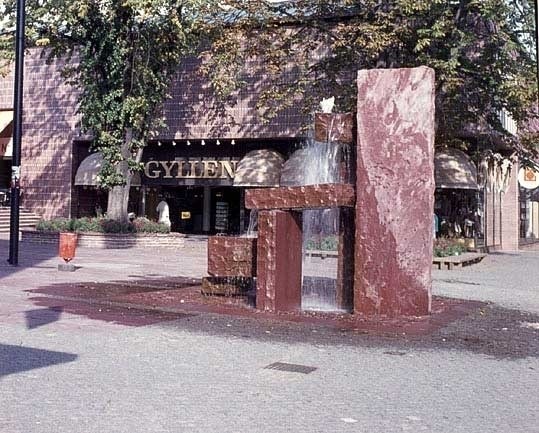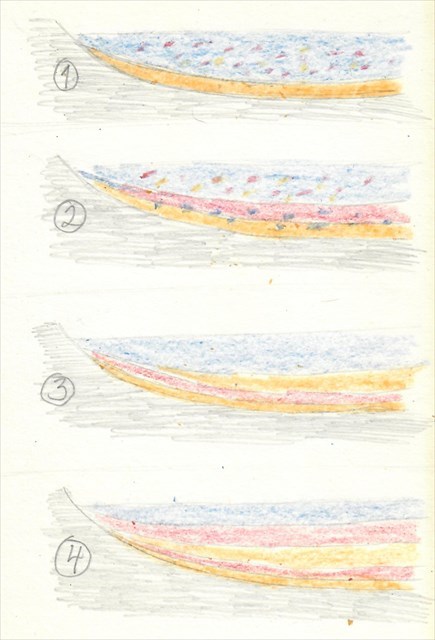Svenska (English below)

Foto Einar Jagerwall. CC BY-NC.
Den här earthcachen kommer att ta dig till statyn "Skulptur med rinnande vatten" (1971) av Oskar Kaunitz. Statyn består av ett antal stenblock där man tydligt kan se spår av sedimentering. I närområdet finns fler inslag av tydligt sedimenterad sten, exempelvis i en trappa, men här räcker det med att titta på statyn. Eftersom statyn består av tydliga rätblock är det lätt att se olika slags spår av sedimenteringen.

Sedimentering är en av de processer genom vilka olika sorters sten kan skapas. I det här fallet handlar det om hur någon form av material som transporteras av vatten (sand, exempelvis) successivt sjunker ner till botten när vattenströmmen inte är stark nog att forsla materialet vidare. Efter lång tid kan detta ansamlade material, ibland under inverkan av högt tryck eller olika kemiska processer, omvandlas till sten. Beroende på den exakta kombinationen av tryck, sedimenterat material och kemiska förutsättningar så kan olika stenarter bildas. Här är det dock inte så mycket den bildade stenarten vi ska intressera oss för som hur den resulterande stenen är strukturerad.
 Processen från att det börjar samlas sediment på botten av ett vattendrag består av flera steg och tar lång tid. Här är en grov översikt:
Processen från att det börjar samlas sediment på botten av ett vattendrag består av flera steg och tar lång tid. Här är en grov översikt:
1: Löst material som transporteras med vattnet sjunker och bildar så småningom ett lager av sediment på botten.
2: Med tiden samlas allt mer material och de undre lagren kompakteras.
3: Så småningom gör den samlade vikten av flera lager att vattnet pressas ut ur de undre lagren och de kan kompakteras ytterligare.
4: Saltkristaller i sedimentet kan cementera ihop de hårt ihoppressade lagren och så småningom bildas en sedimentär bergart.
Eftersom sand i själva verket är små fragment av sten som på det här sättet kan ombildas till sten så brukar man säga att sedimentering är motsatsen till processen erosion som är när en sten nöts ner av vatten eller någon annan form av påverkan.
Sedimentära bergarter är ofta inte homogena. De kan innehålla strukturella spår av processen som skapade dem i form av diverse mönster av olika slag. Det kan också förekomma att annat än sand faller ner till botten och begravs i sediment och sedan så småningom omvandlas till delar av stenen. När djur eller växter fastnar i sten på det här sättet kallas det för fossilisering och är en viktig källa till kunskap om urtida flora och fauna.
Frågor att svara på för att få logga cachen
- Är alla stenblock i statyn placerade i samma orientering som de har bildats, eller har de vridits? Hur vet du det? Vilken orientering hade blocken när de bildades?
- Titta på den norra sidan av det översta blocket i statyn. Mönstret på den här sidan avviker från de övriga blocken. Hur tror du att detta mönster har bildats?
- Hur stora korn ser du i stenblocken? Är de lika stora överallt eller varierar de mycket?
- Ser du några fossil i blocken i statyn?
- Skicka gärna med ett foto på dig och statyn i loggen, men det är helt frivilligt.
Skicka svaren till mig via min profil (skriv dem inte i loggen). Det går utmärkt att logga direkt när du har skickat in dina svar. Om något skulle vara fel så hör jag av mig, men annars inte.
English

Photo Einar Jagerwall. CC BY-NC.
This earthcache will take you to the statue "Skulptur med rinnande vatten" ("Sculpture with running water", 1971) by Oskar Kaunitz. The statue consists of a number of stone blocks where traces of sedimentation can be clearly seen. Nearby are other examples of rocks with clearly sedimentary rocks, for example in stairs, but for this cache it's enough to look at the statue. Since the statue consists of squares it's easy to see different traces of the sedimentation.

Sedimentation is one of the processes through which rocks can be created. In this case, some form of material is transported by water (sand, for instance) and then slowly sink to the bottom when the stream is no longer strong enough to transport the material further. After a long time, this collected material (sometimes under the influence of high pressure or other chemical processes) will be transformed to rock. Depending on the exact combination of pressure, sediment and chemical conditions different types of rock may be created. Here we are not so much interested in the type of rock being created as in how the created rock is structured.
 The process from that sediment starts to collect on the bottom of a body of water consists of several steps and takes a long time. Here is a rough overview:
The process from that sediment starts to collect on the bottom of a body of water consists of several steps and takes a long time. Here is a rough overview:
1: Loose material transported with the water sinks and successively created a layer of sediment on the bottom.
2: In time, more and more material collects and the lower layers are compacted.
3: Later the collected weight of several layers cause the water to be expelled from the lower layers to that they can be further compacted.
4: Salt crystals in the sediment can cement the firmly pressed layers and in time a sedimentary type of rock is created.
Since sand is actually small fragments of rock which in this way can be reformed into rock, one can say that sedimendation is the inverse process of erosion which is when a rock is ground down by water or some other form of process.
Sedimentary types of rocks are often not homogenous. They can contain structural traces of the process that created them in the form of various patterns. It can also happen that other things than sand falls to the bottom and is butied in sediment and is then transformed to be part of the rock. When animals or plants get stuck in stone in this way it's called fossilization and is an important source of knowledge about ancient flora and fauna.
Questions to answer to log the cache
- Are all the stone blocks in the statue placed in the same orientation as they were created, or have they been turned? How do you know that? Which orientation did the blocks have when they were created?
- Look at the north side of the top block of the statue. The pattern on this side is different from the other blocks. How do you think this pattern was created?
- How large particles can you see in the stone blocks? Are they of equal size everywhere or do they vary a lot?
- Can you See any fossils in the blocks of the statue?
- Please include of photo of yourself and the statue in your log, but this is entirely voluntary.
Send your answers to me via my profile (don't write them in your log). You can log the cache as soon as you have sent your answers. If there is a problem with your answers I'll get back to you, but otherwise not.